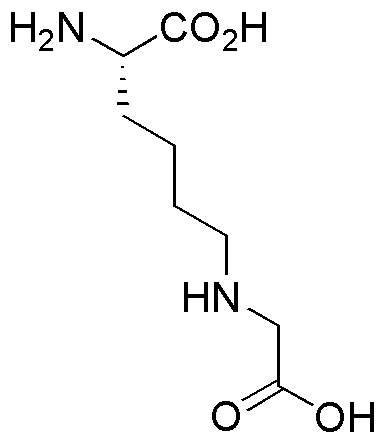Ne-Carboxymethyl-L-lysine is widely utilized in research focused on:
- Food Industry: Used as a food additive to enhance flavor and preserve freshness, providing a natural alternative to synthetic preservatives.
- Pharmaceuticals: Acts as a key ingredient in drug formulations, particularly in developing treatments for metabolic disorders, due to its ability to influence amino acid metabolism.
- Biotechnology: Employed in the production of biopharmaceuticals, where it helps stabilize proteins and improve their efficacy, offering advantages over traditional stabilizers.
- Cosmetics: Incorporated into skincare products for its moisturizing properties, helping to improve skin hydration and elasticity, making it a popular choice among formulators.
- Research Applications: Used in scientific studies to investigate the role of amino acids in cellular processes, aiding researchers in understanding metabolic pathways and disease mechanisms.
General Information
Properties
Safety and Regulations
Applications
Ne-Carboxymethyl-L-lysine is widely utilized in research focused on:
- Food Industry: Used as a food additive to enhance flavor and preserve freshness, providing a natural alternative to synthetic preservatives.
- Pharmaceuticals: Acts as a key ingredient in drug formulations, particularly in developing treatments for metabolic disorders, due to its ability to influence amino acid metabolism.
- Biotechnology: Employed in the production of biopharmaceuticals, where it helps stabilize proteins and improve their efficacy, offering advantages over traditional stabilizers.
- Cosmetics: Incorporated into skincare products for its moisturizing properties, helping to improve skin hydration and elasticity, making it a popular choice among formulators.
- Research Applications: Used in scientific studies to investigate the role of amino acids in cellular processes, aiding researchers in understanding metabolic pathways and disease mechanisms.
Documents
Safety Data Sheets (SDS)
The SDS provides comprehensive safety information on handling, storage, and disposal of the product.
Product Specification (PS)
The PS provides a comprehensive breakdown of the product’s properties, including chemical composition, physical state, purity, and storage requirements. It also details acceptable quality ranges and the product's intended applications.
Certificates of Analysis (COA)
Search for Certificates of Analysis (COA) by entering the products Lot Number. Lot and Batch Numbers can be found on a product’s label following the words ‘Lot’ or ‘Batch’.
*Catalog Number
*Lot Number
Certificates Of Origin (COO)
This COO confirms the country where the product was manufactured, and also details the materials and components used in it and whether it is derived from natural, synthetic, or other specific sources. This certificate may be required for customs, trade, and regulatory compliance.
*Catalog Number
*Lot Number
Safety Data Sheets (SDS)
The SDS provides comprehensive safety information on handling, storage, and disposal of the product.
DownloadProduct Specification (PS)
The PS provides a comprehensive breakdown of the product’s properties, including chemical composition, physical state, purity, and storage requirements. It also details acceptable quality ranges and the product's intended applications.
DownloadCertificates of Analysis (COA)
Search for Certificates of Analysis (COA) by entering the products Lot Number. Lot and Batch Numbers can be found on a product’s label following the words ‘Lot’ or ‘Batch’.
*Catalog Number
*Lot Number
Certificates Of Origin (COO)
This COO confirms the country where the product was manufactured, and also details the materials and components used in it and whether it is derived from natural, synthetic, or other specific sources. This certificate may be required for customs, trade, and regulatory compliance.


